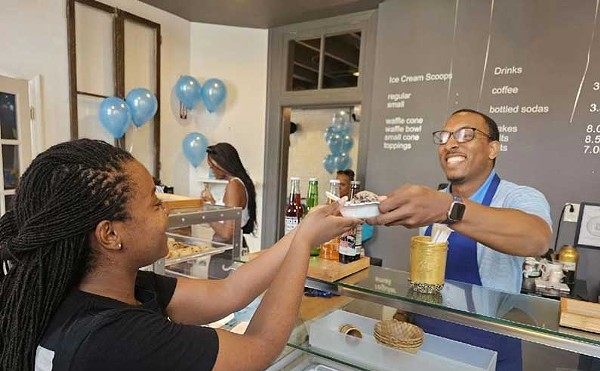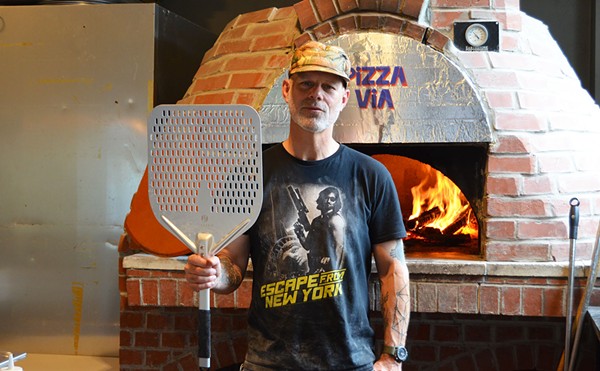Bognar was one of the forces in expanding options for Thai food out to western and southwestern St. Louis County, in the form of Manee Thai on Manchester and Sukho Thai at Watson and Mackenzie. Both restaurants offer very good Thai food, not expensive, in well-appointed dining rooms. It's fairly upscale for local Thai/Southeast Asian and definitely worth repeat visits, but not transcendent.
Nippon Tei, on the other hand, is special.
As with her previous creations, Bognar has taken a generic strip-mall space and managed to transform it into a different world. At Nippon Tei, deep-red walls are juxtaposed with orange-marmalade ones, blond wood is everywhere and sparsely placed but striking flower arrangements -- orchids on the host's station, purple statice in an unusual triangular vase under a modernist lamp in a corner -- providing notice that everything that eventually arrives on your plate is going to be placed just so.
The menu uses the word "fusion" to describe what's going on with the food, but I might quibble with that just slightly; most of what we tried, plus a reading of the rest of the available offerings, seemed to indicate that the accent was predominantly Japanese. (Even the name, which means, roughly, "a form or appearance of Japan," focuses on a single culture.) Nonetheless, the menu certainly features various elements of cross-cultural influences, especially among the "specialties," such as wasabi lightened into a cream sauce for scallops or a Thai-touched coconut curry for freshwater prawns.
Aside from the specialties -- which, being in the $15-$20 range, are the most expensive selections -- the menu is divided into entrées, noodles, rice, "small plates," soups, "cool dishes," sushi and vegetarian items, providing the opportunity to make a small meal of many things. There's no specific section for appetizers, so we used the sushi chef's predetermined combination, nigiri deluxe, as the starting course for one of our meals.
Good sushi has become easy to find around here in the past decade, and given that the Nippon Tei sushi chef once worked for local sushi godfather Noboru Kidera at Nobu's, it's not surprising that the sushi here was excellent. The $13.95 combination included tuna, yellowtail, mackerel, salmon and ark clam, along with a seaweed-wrapped roll of tuna. (Sushi can also be ordered by the piece, and another $13.95 combination called Sushi 101 includes only cooked items for those remaining wimps who still can't stomach the concept of eating raw fish.)
On our other visit, we drew our appetizers from among the "small plates": a good-sized portion of lightly breaded and fried soft-shell crab and a superlative tuna tartare. The gently flavored breading on the crab allowed its own mildly sweet flavor to stand out, but the tuna tartare was much more of a conglomeration of flavors, some fairly powerful but none of them blowing away the basic elegance of the coarsely chopped tuna. A ruby-colored heap of it was surrounded by shreds of bell pepper, cabbage and scallion, with fresh lime and randomly scattered cashews as accents, but the eye-opening aspect of the dish was fine rings of red chile along with matchsticks of fresh ginger, each providing a noticeable kick but softening because of absorbing elements, such as the cabbage.
The "entrées," as opposed to the "specialties," are all under 15 bucks, and of these we tried the crispy fried salmon, coated in a roughly textured breading that yielded a thin but crunchy skin. A side container held a balance of sweet, salty and nutty with a sesame-seed-laden sweetened and thickened soy sauce.
The specialties were more elaborate in composition but managed to stick with a small enough number of main themes so that the creativity didn't overwhelm enjoyment of the individual elements. The performance-art choice of the menu was shabu-shabu, which required the setup of a copper cauldron with a center chimney -- not unlike an angelfood-cake pan -- placed on a tabletop gas burner and filled with broth. Next to this, in a black ceramic bowl much like those used to serve large orders of sushi, was an enormous selection of carrots, spinach, scallions, onions, cellophane noodles, a raw egg, rectangles of tofu, processed "fish ball," slices of raw flank steak and roughly half-a-dozen raw tiger shrimp and scallops. The instruction from the waiter was to start with the vegetables and the raw egg to add flavor to the broth, then to cook the various protein items and dip them in ponzu, a citrus-laced soy sauce. At $23.95, it was far and away the most expensive item on the menu, and although not noted as such, it would easily feed two.
On the subtler side were the scallops in wasabi sauce, eight seared, plump, half-dollar-sized mollusks, simply presented alongside five vivid-green stalks of asparagus, all on top of a subtle mint-green bed of cream sauce. The dilution of the wasabi put its fieriness much further into the background, providing a good complement but letting the supple texture and roasty seafood flavor of the scallops form the primary impression of the dish.
Our favorite item was the prawns in ginger curry sauce. In taste and texture, the prawns more closely resembled small lobster tails than shrimp. The dish featured seven large specimens in a coconut-enhanced golden cream sauce, again with the obvious presence of fresh ginger, the combination leaving a residual spicy tang on the middle of the tongue. An ice-cream-scoop portion of sticky rice served as an appropriate collector for every remaining bit of the sauce.
Of the five available desserts, four are simple, pure flavors (raspberry, mango, strawberry and green tea) in sorbet or ice cream; the fifth, taro custard, I would best describe as an Asian variation on sweet-potato pie.
Both of our servers were knowledgeable, polite and attentive (the second time even as the place was packed wall-to-wall on a weekend evening), providing pointers as needed for the more exotic items. Several wines are available, with bottles displayed pronouncedly in a top-lit rack adjacent to the sushi bar, although I generally prefer beer or sake as the best beverage for this type of food.
My wish for Bognar is that she not tire of what she's doing. Given that she has opened three restaurants in less than five years, it might appear that she's always looking ahead to her next adventure. With Nippon Tei, she's found a perfect place to anchor.





